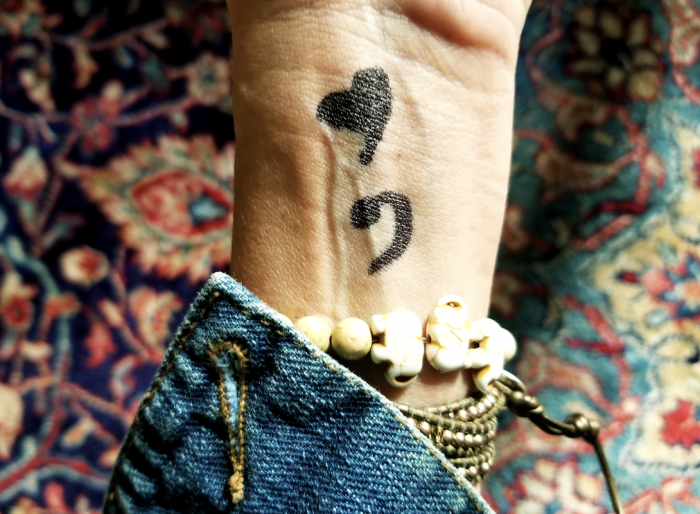My 50th birthday is two days after World Suicide Prevention Day and to celebrate, I’ve been considering a tattoo.
Many of my friends have tattoos, really cool tattoos, but I never imagined myself with one, especially considering I already have five.
I always told my friends I had multiple tattoos, and when they would ask where, I would say they were on my chest—outlining the field for the radiation treatments that I received for Hodgkin’s Disease, back in 2001. And believe me, those five dots were enough for me!
Sitting still for an entire piece of art to be permanently inked on my body was an impossibility for me. Yet, this year, as I achieved my highest level of mental health and clarity, I became determined as hell to represent my mental health community as an advocate and writer. A permanent marking to signify my commitment was one potential way I thought I could do that.
I wasn’t sure what my tattoo would be. I did know it would include a semicolon, for back in 2015 when I was struggling with the worst depression I had experienced in my life, I found an organization called Project Semicolon.
Project Semicolon was founded by Amy Bleul, in 2013, after she lost her father to suicide ten years prior. She created the foundation to create awareness around mental illness, depression, self-harm, and suicide. Bleul herself also suffered from mental illness and as a peer and inspiration, her foundation’s popularity quickly grew.
The foundation’s motto is, “Your story isn’t over,” which hit home with me as a writer. The concept was that rather than using a period to end a thought, a semicolon could be used instead to signify a pause—rather than finality.
Even back in 2015, I knew my story wasn’t over yet as I crossed the threshold of the metal doors, into that hospital for treatment. I held onto the concept of the semicolon. I knew when my inpatient stay had concluded that I would have one hell of a story to tell if I made it through. A story that someday would help others, just like Bleul’s foundation had helped me.
Today, almost seven years later, I have vowed to share that story with hopes of spreading knowledge and awareness about mental illness and suicide. Ending the stigmas against mental illness, the ones that deter people suffering from seeking out help, has become one of my life’s missions.
So why not get a tattoo, you ask?
For one, I am the type of person who likes to change things frequently, whether it be how my desk is arranged, my living room furniture, my kitchen cabinets, or my bedroom closet. I get bored and feel the need to rearrange.
I drive my husband insane (no pun intended) with how frequently I make changes in our house. It’s so bad that every time the commercial for Prevagen, the supplement that helps with memory loss, comes on, he begs me to get him some so he can remember where I have put things.
Having a tattoo in the same place forever caused me great anxiety. I was worried I would get tired of looking at my tattoo in its original location. The realization that I would never be able to relocate it was disconcerting.
Secondly, tattoos are expensive. I had no idea how costly they can be, and more power to you if they are your thing. But for me, I just couldn’t justify it in my mind. I would rather have a lovely evening out with my husband when I could draw the symbol on my wrist daily if I really wanted to do so.
I was comforted to read on Project Semicolon’s website that a permanent tattoo was not a requirement but rather by donning the semicolon, even in pen, was support enough.
Most importantly, I realized basically everything in life is temporary, except a tattoo, death, and, of course, suicide.
Life, faith, money, happiness, love, and depression are all temporary. I decided that for me to better represent the motto of Project Semicolon, I would share my story and advocate to end the stigma of mental illness. I will work to educate and enlighten those who do not understand depression and suicide.
And, I will pen the semicolon onto whichever body part I prefer that day to show my appreciation and support of Project Semicolon’s mission.
Sadly, I found out that Amy Bleul’s life was cut short when she committed suicide in 2017—which shows how fragile life is, no matter how much we try to take care of ourselves and no matter how much education and insight we may have.
Hence, please, heed my call once again as I ask for your help to spread the word about mental illness and suicide.
Despite the founder’s tragic death, Project Semicolon is still in operation and provides valuable services to the mental health population, including advocacy and empowerment.
Check out their website which is full of resources, educational information on the various mental health diagnoses, medications used for treatments, and even a special section just for teens! They even have an app.
Bleul’s legacy still lives on despite her death and the one million people that die annually each year due to suicide.
The site also offers assessment tools, including one to assess your suicide risk.
The Suicide Risk Assessment Test consists of the following questions:
Answer them based on your feelings over the previous two weeks.
1. In the past few weeks, have you wished you were dead?
2. In the past few weeks, have you felt that you or your family would be better off if you were dead?
3. In the past week, have you been having thoughts of killing yourself?
4. Have you ever tried to kill yourself?
5. Are you having thoughts of killing yourself now?
I took the test. In about 90 seconds, and although my risk is extremely low today, I would have answered “yes” to every question asked back in 2015. The results calculate while you wait and depending upon your risk score, the site provides you resources and contact information.
If you don’t have access to the site, you can still take the test. According to the National Institute of Mental Health, if you answer “yes” to any of the questions 1 through 4, you would be considered to have a positive screening for suicide risk, and you should seek help right away.
If you or someone else answers “yes” to Question 5, call for help immediately and do not let the person out of your sight.
If you answered “yes” to question five and no one is with you, call 911 or the National Suicide Prevention Hotline who accepts calls or texts 24 hours a day at 1-800-273-8255.
On September 10th, I will display a semicolon on my wrist to signify my support of Project Semicolon, to let others know my story is not over yet, and to carry on Amy Bleul’s legacy by spreading awareness regarding mental illness and suicide on World Suicide Prevention Day.
Although it may not be a permanent tattoo, it will be drawn on my body in black permanent ink. I will watch and admire the symbolism as the ink eventually fades—just as my depression has over the years.
Even when the mark is gone, I will always remember what it was like to live with mental illness and depression or to feel as if death was the best option. I will always remember finding Project Semicolon and how it inspired hope in me.
To pay it forward, I will continue to share my story to honor Bleul and Project Semicolon’s vision that one day, we can all live in “a world where all people affected by mental illness live healthy, fulfilling lives supported and inspired by a community who cares.”








Read 16 comments and reply